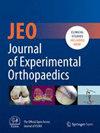Limited clinical benefit of medial meniscus posterior root repair combined with high tibial osteotomy in varus knee osteoarthritis: A systematic review and meta-analysis
Abstract
Purpose
Medial meniscus posterior root tears (MMPRTs) are biomechanically comparable to total meniscectomy, leading to meniscal extrusion, increased tibiofemoral contact pressure and accelerated osteoarthritis (OA) in varus-aligned knees. While high tibial osteotomy (HTO) is effective in unloading the medial compartment, the added value of repairing the MMPRT during HTO remains debated. This systematic review and meta-analysis aimed to evaluate whether combined MMPRT repair and HTO provide superior short-term clinical and radiological outcomes compared to HTO alone.
Methods
A systematic search of PubMed, Cochrane and Scopus was performed in March 2025. Comparative studies evaluating HTO with or without concurrent MMPR repair in patients with varus knee and medial OA were included. Primary outcomes were clinical scores (International Knee Documentation Committee [IKDC], Lysholm, Knee Society Score [KSS] and Hospital for Special Surgery [HSS]), radiographic parameters (joint line convergence angle [JLCA], hip–knee–ankle [HKA] angle and joint space width), meniscal extrusion and second-look arthroscopic findings. Statistical analysis was conducted using a random-effects model with Review Manager 5.4.
Results
Eight retrospective comparative studies (n = 630 patients) met the inclusion criteria. MMPRT repair plus HTO demonstrated statistically higher IKDC scores (MD = 3.56; p = 0.001) compared to HTO alone; however, there were no significant differences between groups in terms of Lysholm, KSS function and HSS scores. Radiographically, minimal improvements were noted in JLCA (MD = −0.25; p = 0.006), without clear clinical implications. Meniscal extrusion did not differ significantly between groups (MD = 0.30; p = 0.72). Second-look arthroscopy revealed complete root healing in 22% of cases. The risk of bias was moderate to high.
Conclusion
Short-term follow-up shows that combining MMPRT repair with HTO yields statistically better IKDC clinical scores. Furthermore, the actual benefit of combining MMPRT repair with HTO in routine clinical practice is questionable. Prospective studies with longer follow-up are required to clarify the long-term clinical impact of MM.
Level of Evidence
Level III, systematic review and meta-analysis.





 求助内容:
求助内容: 应助结果提醒方式:
应助结果提醒方式:


